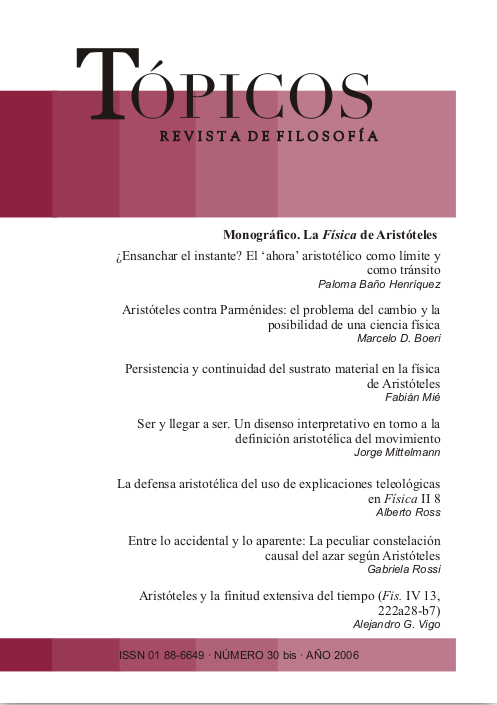Publicado 2013-11-28
Palabras clave
- Aristóteles,
- Física,
- W. D. Ross,
- movimiento,
- ser.
Cómo citar
Resumen
Este artículo intenta comparar dos interpretaciones diferentes de la relación entre una capacidad y su correspondiente actualidad en Física III. El autor se concentra en la legitimidad de una distinción entre “capacidad de ser” y “capacidades de devenir”. Esta distinción se aplica a la interpretación de la definición de movimiento de Aristóteles. Mittelmann discute la circularidad que parece resultar de un recurso a “capacidades dinámicas”; luego se propone mostrar que el modo alternativo de construir la posición de Aristóteles por referencia a la actualización incompleta de “capacidades de ser” produce algunas consecuencias contra-intuitivas. El trabajo termina por señalar que ambas estrategias llevan a una alternativa: o la definición aristotélica de movimiento debe aceptarse sin objeciones (corriendo el riesgo de hacer tal definición inaplicable a un conjunto de fenómenos que se supone que explica) o debe ser rectificada en el sentido sugerido por W. D. Ross, pero a riesgo de hacer la definición circular.
Referencias
- Ackrill, J. L. (1965). Aristotle’s distinction between energeia and kinesis. En New Essays on Plato and Aristotle. R. Bambrough (ed.) (121-141). Londres.
- Aristóteles. (1924). Metaphysics. W. D. Ross (ed.) Oxford.
- ____ (1936). Physics. W. D. Ross (ed.) Oxford.
- ____ (1982). De Generatione et Corruptione. C. J. F. Williams (trans) Oxford.
- ____ (1995). Física. Libros III y IV. A. Vigo (trad.) Buenos Aires.
- Charles, D. (1984). Aristotle’s Philosophy of Action. London.
- ____ (1994). Matter and form: unity, persistence and identity. En Unity, Identity and Explanation in Aristotle’s Metaphysics. D. Charles, M. L. Gill y T. Scaltsas (eds.) (75-105). Oxford.
- Filópono, J. (1897). In Aristotelis Libros De Generatione et Corruptione Commentaria. En Commentaria in Aristotelem Graeca. Vol. 14. H. Vitelli (ed.) Berlin.
- Frede, M. (1994). Aristotle’s notion of potentiality in Metaphysics Θ. En Unity, Identity and Explanation in Aristotle’s Metaphysics. D. Charles, M. L. Gill y T. Scaltsas (eds.) (173-193). Oxford.
- Gill, M. L. (1989). Aristotle on substance. The paradox of unity. Princeton.
- Halper, E. (1984). Aristotle on knowledge of nature. En Review of Metaphysics, 37: 811-835.
- Irwin, T. (1990). Aristotle’s First Principles. Oxford.
- Kosman, L. A. (1969). Aristotle’s definition of motion. En Phronesis, 14: 40-62.
- ____ (1984). Substance, being and energeia. En Oxford Studies in Ancient Philosophy, 2: 121-149.
- Lewis, F. (1994). Aristotle on the relation between a thing and its matter. En Unity, Identity and Explanation in Aristotle. D. Charles, M. L. Gill y T. Scaltsas (eds.) (247-277). Oxford.
- Natali, C. (1991). Movimenti ed attività. L’interpretazione di Aristotele, Metaph. 6. En Elenchos, 12: 67-90.
- ____ (2002). Actions et mouvements chez Aristote. En Philosophie, 73: 12-35.
- Penner, T. (1970). Verbs and the identity of actions. En Ryle. G. Pitcher y O. P. Wood (eds.) Garden City.
- Wieland, W. (1970). Die aristotelische Physik. Göttingen.






